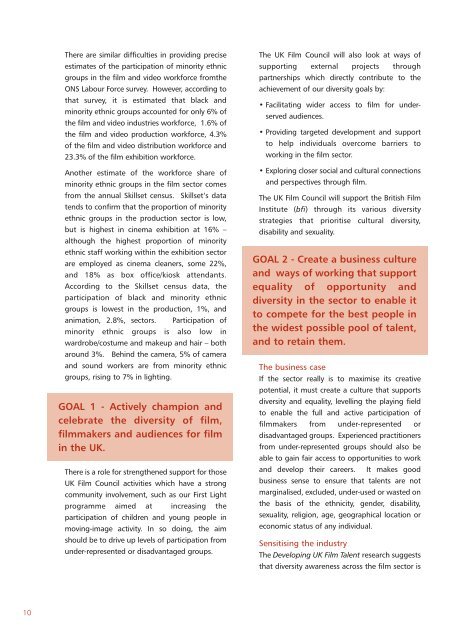Success through diversity and inclusion - BFI - British Film Institute
Success through diversity and inclusion - BFI - British Film Institute
Success through diversity and inclusion - BFI - British Film Institute
You also want an ePaper? Increase the reach of your titles
YUMPU automatically turns print PDFs into web optimized ePapers that Google loves.
10<br />
There are similar difficulties in providing precise<br />
estimates of the participation of minority ethnic<br />
groups in the film <strong>and</strong> video workforce fromthe<br />
ONS Labour Force survey. However, according to<br />
that survey, it is estimated that black <strong>and</strong><br />
minority ethnic groups accounted for only 6% of<br />
the film <strong>and</strong> video industries workforce, 1.6% of<br />
the film <strong>and</strong> video production workforce, 4.3%<br />
of the film <strong>and</strong> video distribution workforce <strong>and</strong><br />
23.3% of the film exhibition workforce.<br />
Another estimate of the workforce share of<br />
minority ethnic groups in the film sector comes<br />
from the annual Skillset census. Skillset’s data<br />
tends to confirm that the proportion of minority<br />
ethnic groups in the production sector is low,<br />
but is highest in cinema exhibition at 16% –<br />
although the highest proportion of minority<br />
ethnic staff working within the exhibition sector<br />
are employed as cinema cleaners, some 22%,<br />
<strong>and</strong> 18% as box office/kiosk attendants.<br />
According to the Skillset census data, the<br />
participation of black <strong>and</strong> minority ethnic<br />
groups is lowest in the production, 1%, <strong>and</strong><br />
animation, 2.8%, sectors. Participation of<br />
minority ethnic groups is also low in<br />
wardrobe/costume <strong>and</strong> makeup <strong>and</strong> hair – both<br />
around 3%. Behind the camera, 5% of camera<br />
<strong>and</strong> sound workers are from minority ethnic<br />
groups, rising to 7% in lighting.<br />
GOAL 1 - Actively champion <strong>and</strong><br />
celebrate the <strong>diversity</strong> of film,<br />
filmmakers <strong>and</strong> audiences for film<br />
in the UK.<br />
There is a role for strengthened support for those<br />
UK <strong>Film</strong> Council activities which have a strong<br />
community involvement, such as our First Light<br />
programme aimed at increasing the<br />
participation of children <strong>and</strong> young people in<br />
moving-image activity. In so doing, the aim<br />
should be to drive up levels of participation from<br />
under-represented or disadvantaged groups.<br />
The UK <strong>Film</strong> Council will also look at ways of<br />
supporting external projects <strong>through</strong><br />
partnerships which directly contribute to the<br />
achievement of our <strong>diversity</strong> goals by:<br />
• Facilitating wider access to film for underserved<br />
audiences.<br />
• Providing targeted development <strong>and</strong> support<br />
to help individuals overcome barriers to<br />
working in the film sector.<br />
• Exploring closer social <strong>and</strong> cultural connections<br />
<strong>and</strong> perspectives <strong>through</strong> film.<br />
The UK <strong>Film</strong> Council will support the <strong>British</strong> <strong>Film</strong><br />
<strong>Institute</strong> (bfi) <strong>through</strong> its various <strong>diversity</strong><br />
strategies that prioritise cultural <strong>diversity</strong>,<br />
disability <strong>and</strong> sexuality.<br />
GOAL 2 - Create a business culture<br />
<strong>and</strong> ways of working that support<br />
equality of opportunity <strong>and</strong><br />
<strong>diversity</strong> in the sector to enable it<br />
to compete for the best people in<br />
the widest possible pool of talent,<br />
<strong>and</strong> to retain them.<br />
The business case<br />
If the sector really is to maximise its creative<br />
potential, it must create a culture that supports<br />
<strong>diversity</strong> <strong>and</strong> equality, levelling the playing field<br />
to enable the full <strong>and</strong> active participation of<br />
filmmakers from under-represented or<br />
disadvantaged groups. Experienced practitioners<br />
from under-represented groups should also be<br />
able to gain fair access to opportunities to work<br />
<strong>and</strong> develop their careers. It makes good<br />
business sense to ensure that talents are not<br />
marginalised, excluded, under-used or wasted on<br />
the basis of the ethnicity, gender, disability,<br />
sexuality, religion, age, geographical location or<br />
economic status of any individual.<br />
Sensitising the industry<br />
The Developing UK <strong>Film</strong> Talent research suggests<br />
that <strong>diversity</strong> awareness across the film sector is

















